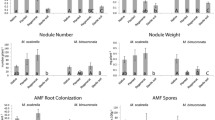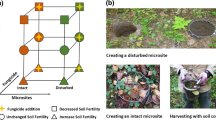Abstract.
This paper explores if Mimosa species (Fabaceae-Mimosoideae) can serve as arbuscular mycorrhizal (AM) and nutrient "resource islands" in six plant communities in the semiarid valley of Tehuacán-Cuicatlán, Mexico. Spatial heterogeneity related to the occurrence of Mimosa species results in temporal differences in AM-fungal spore numbers and soil nutrients. A higher number of AM-fungal spores were found in the soil below the canopies of six endemic Mimosa species than in the soil from non-vegetated areas. For four species, Mimosa adenantheroides, Mimosa calcicola, Mimosa luisana and Mimosa polyantha, the soil below their canopies had more AM-fungal spores than the soil in non-vegetated areas during the wet season than during the dry season. Two species, Mimosa lacerata and Mimosa texana var. filipes, however, had more spores under their canopies during the dry season than during the wet season. Although physical differences are present within and between sites, in general the soil below the canopies of Mimosa species had significantly higher nutrient levels than the soil from non-vegetated areas. Mimosa species thus form "resource islands" that are not only rich in nutrients but also in mycorrhizal propagules. Mimosa species can serve as mycorrhizal "resource islands" by directly affecting AM-fungal spore dynamics and/or by serving as spore-traps. A range of plants associated with Mimosa species may benefit from the higher number of AM propagules. We believe that the use of Mimosa resource islands as an option for biodiversity conservation and for land restoration ought to be considered in the Valley.
Similar content being viewed by others
References
Allen EB, Allen MF (1986) Water relations of xeric grasses in the field: interactions of mycorrhizas and competition. New Phytol 104:559–571
Allen MF (1991) The ecology of mycorrhizae. Cambridge University Press, New York
Allen MF, Smith WK, Moore TS, Christensen M (1981) Comparative water relations and photosynthesis of mycorrhizal and non-mycorrhizal Bouteloua gracilis. New Phytol 88:683–693
Anderson RC, Liberta AE, Dickman LA (1984) Interaction of vascular plants and vesicular-arbuscular mycorrhizal fungi across a soil moisture-nutrient gradient. Oecologia 64:111–117
Bethlenfalvay GJ, Dakessian S, Pacovsky RS (1984) Mycorrhizae in southern California desert: ecological implications. Can J Bot 62:519–524
Brundrett M (1991) Mycorrhizas in natural ecosystems. Adv Ecol Res 21:171–313
Camargo-Ricalde SL, Dhillion SS, Grether R (2002a) Community structure of endemic Mimosa species and environmental heterogeneity in a semi-arid Mexican valley. J Veg Sci 13 (in press)
Camargo-Ricalde SL, Dhillion SS, Jiménez-González C (2002b) Mycorrhizal perennials of the "matorral xerófilo" and the "selva baja caducifolia" communities in the semiarid Tehuacán-Cuicatlán Valley, Mexico. Mycorrhiza (in press)
Carrillo-García A, León de la Luz JL, Bashan Y, Bethlenfalvay GJ (1999) Nurse plants, mycorrhizae, and plant establishment in a disturbed area of the Sonoran Desert. Rest Ecol 7:321–335
Casas A, Valiente-Banuet A, Viveros JL, Caballero J, Cortés L, Dávila P, Lira R, Rodríguez I (2001) Plant resources of the Tehuacán-Cuicatlán Valley, Mexico. Econ Bot 55:129–166
Coleman DC, Reid CPP, Cole CV (1983) Biological strategies of nutrient cycling in soil systems. Adv Ecol Res 13:1–55
Dhillion SS (1999) Environmental heterogeneity, animal disturbances, microsite characteristics, and seedling establishment in a Quercus havardii community. Rest Ecol 7:399–406
Dhillion SS, Anderson RC (1993) Seasonal dynamics of dominant species of arbuscular mycorrhizae in burned and unburned sand prairies. Can J Bot 71:1625–1630
Dhillion SS, Zak JC (1993) Microbial dynamics in arid ecosystems: desertification and the potential role of Mycorrhizas. Rev Chil Hist Nat 66:253–270
Dhillion SS, McGinley MA, Friese CF, Zak JC (1994) Construction of sand shinnery oak communities of the Llano Estacado: animal disturbances, plant community structure and restoration. Rest Ecol 2:51–60
Dhillion SS, Vidiella PE, Aquilera LE, Friese CF, De León E, Armesto JJ, Zak JC (1995) Mycorrhizal plants and fungi in the fog-free Pacific coastal desert of Chile. Mycorrhiza 5:381–386
Fitter AH, Garbaye J (1994) Interactions between mycorrhizal fungi and other soil organisms. Plant Soil 159:123–132
Garbaye J (1991) Biological interactions in the mycorrhizosphere. Experentia 47:370–375
García-Moya E, McKell CM (1970) Contribution to the nitrogen economy of a desert-wash plant community. Ecology 51:81–88
Garner W, Steinberger Y (1989) A proposed mechanism for the formation of "Fertile Islands" in the desert ecosystem. J Arid Environ 16:257–262
Gazey C, Abbott LK, Robson AD (1992) The rate of development of mycorrhizas affects the onset of sporulation and production of external hyphae by two species of Acaulospora. Mycol Res 96:643–650
Gerdemann JW, Nicolson TH (1963) Spores of mycorrhizal Endogone species extracted from soil by wet sieving and decanting. Trans Br Mycol Soc 46:235–244
Gibson DJ, Hetrick BAD (1988) Topographic and fire effects on the composition and abundance of VAM-mycorrhizal fungi in a tallgrass prairie. Mycologia 80:433–441
Grether R, Camargo-Ricalde SL, Martínez-Bernal A (1996) Species of genus Mimosa (Leguminosae) in Mexico (in Spanish with English summary). Bol Soc Bot Mex 58:149–152
Hoffman MT, Mitchell DT (1986) The root morphology of some legume spp. in the south-western Cape and the relationship of vesicular-arbuscular mycorrhizas with dry mass and phosphorus content of Acacia saligna seedlings. S Afr J Bot 52:316–320
Jacobson KM (1997) Moisture and substrate stability determine VA-mycorrhizal fungal community distribution and structure in an arid grassland. J Arid Environ 35:59–75
Johnson NC, Tilman D, Wedin D (1992) Plant and soil controls on mycorrhizal fungal communities. Ecology 73:2034–2042
Martínez-Bernal A, Grether R (2002) Mimosa (in Spanish). In: Kelly L, Medina-Lemos R (eds) Flora del Valle de Tehuacán-Cuicatlán. Number 33, Biology Institute, National Autonomous University of Mexico (UNAM) (in press)
Mayo K, Davis RE, Motta J (1986) Stimulation of germination of spores of Glomus versiforme by spore-associated bacteria. Mycologia 78:426–431
McGee P (1989) Variation in propagule numbers of vesicular-arbuscular mycorrhizal fungi in a semi-arid soil. Mycol Res 92:28–33
Merryweather J, Fitter AH (1998) The arbuscular mycorrhizal fungi of Hyacinthoides non-scripta. II. Seasonal and spatial patterns of fungal populations. New Phytol 138:131–142
Mosse B, Bowen GD (1968) The distribution of Endogone spores in some Australian and New Zealand soils, and in an experimental field soil at Rothamsted. Trans Br Mycol Soc 51:485–492
Nadian H, Smith SE, Alston AM, Murray RS, Siebert BD (1998) Effects of soil compaction on phosphorus uptake and growth of Trifolium subterraneum colonized by four species of vesicular-arbuscular mycorrhizal fungi. New Phytol 139:155–165
Reynolds JF, Virginia RA, Kemp PR, de Soyza AG, Tremmel DC (1999) Impact of drought on desert shrubs: effects of seasonality and degree of resource islands development. Ecol Monogr 69:69–106
Sanders IR, Fitter AH (1992) The ecology and functioning of vesicular-arbuscular mycorrhizas in co-existing grassland species. I. Seasonal patterns of mycorrhizal occurrence and morphology. New Phytol 120:517–524
Schenck NC, Perez Y (1990) Manual of the identification of VA mycorrhizal fungi. Synergistic Publications, Gainesville, Fla.
Snyder R, Friese CF (2001) A survey of arbuscular mycorrhizal fungal root inoculum associated with harvester ants nests (Pogonomyrmex occidentalis) across the western United States. Mycorrhiza 11:163–165
Sousa M, Delgado A (1993) Mexican Leguminosae: phytogeography, endemism, and origins. In: Ramamoorthy TP, Bye R, Lot A, Fa J (eds) Biological diversity of Mexico: origins and distribution. Oxford University Press, Oxford, pp 459–511
Stürmer SL, Bellei MM (1994) Composition and seasonal variation of spore populations of arbuscular mycorrhizal fungi in dune soils on the island of Santa Catarina, Brazil. Can J Bot 72:359–363
Tarafdar JC, Praveen-Kumar (1996) The role of vesicular arbuscular mycorrhizal fungi on crop, tree and grasses grown in an arid environment. J Arid Environ 34:197–203
Tiedemann AR, Klemmedson JO (1973) Effect of mesquite on physical and chemical properties of the soil. J Range Manage 26:27–29
Valiente-Banuet A, Ezcurra E (1991) Shade as a cause of the association between the cactus Neobuxbaumia tetetzo and the nurse plant Mimosa luisana in the Tehuacán Valley, Mexico. J Ecol 79:961–971
Valiente-Banuet A, Vite F, Zavala-Hurtado JA (1991) Interaction between the cactus Neobuxbaumia tetetzo and the nurse shrub Mimosa luisana. J Veg Sci 2:11–14
Van der Heijden MGA, Klironomos JN, Ursic M, Moutoglis P, Streitwolf-Engel R, Boller T, Wiemken A, Sanders IR (1998) Mycorrhizal fungal diversity determines plant biodiversity, ecosystem variability and productivity. Nature 396:69–72
Vázquez-Alarcón A, Bautista-Aroche N (1993) Soil and water chemical analysis interpretation guide (in Spanish). Universidad Autónoma Chapingo, Department of Soils, Mexico
Virginia RA, Jenkins MB, Jarrel WM (1986) Depth of root symbiont occurrence in soil. Biol Fertil Soils 2:127–130
Walker C, Mize CW, McNabb HS Jr (1982) Populations of endogonaceous fungi at two locations in central Iowa. Can J Bot 60:2518–2529
Warner NJ, Allen MF, MacMahon JA (1987) Dispersal agents of vesicular-arbuscular mycorrhizal fungi in a disturbed arid ecosystem. Mycologia 79:721–730
Whitford W (1996) The importance of the biodiversity of soil biota in arid ecosystems. Biodivers Conserv 5:185–195
Zak JC, Sinsabaugh R, MacKay WP (1995) Windows of opportunity in desert ecosystems: their implications to fungal community development. Can J Bot 73:S1407–S1414
Zavala-Hurtado JA, Hernández-Cárdenas G (1998) Characterization and diagnosis study of the area proposed as Tehuacán-Cuicatlán Biosphere Reserve (in Spanish). Universidad Autónoma Metropolitna-Instituto Nacional de Ecología (SEMARNAP), México
Zobel M, Moora M, Haukioja E (1997) Plant coexistence in the interactive environment: arbuscular mycorrhiza should not be out of mind. Oikos 78:202–208
Acknowledgements.
We thank Carolina Jiménez Gonzáles and Verónica García García for their assistance in the laboratory and the fieldwork, Rosalva García Sánchez for her logistic support, and two reviewers for their constructive comments. This work was supported in part by the Consejo Nacional de Ciencia y Tecnología (CONACyT, grant 112386 to S.L. C.-R.) and the Universidad Autónoma Metropolitana. This work is part of the Management of Biodiversity Research and TERG group at the Agricultural University of Norway led by S.S.D.
Author information
Authors and Affiliations
Corresponding author
Rights and permissions
About this article
Cite this article
Camargo-Ricalde, S.L., Dhillion, S.S. Endemic Mimosa species can serve as mycorrhizal "resource islands" within semiarid communities of the Tehuacán-Cuicatlán Valley, Mexico. Mycorrhiza 13, 129–136 (2003). https://doi.org/10.1007/s00572-002-0206-5
Received:
Accepted:
Published:
Issue Date:
DOI: https://doi.org/10.1007/s00572-002-0206-5




